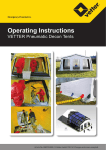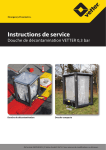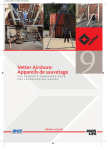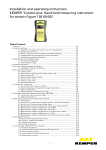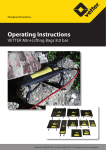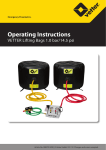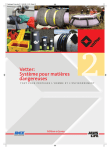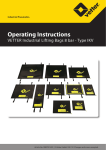Download Operating Instructions
Transcript
Emergency Pneumatics. Operating Instructions VETTER Medical Tents Article No. 9987043403 | © Vetter GmbH I 09/14 I Changes and errors excepted. Vetter Medical Tents Contents 1. Important preliminary remarks. . . . . . . . . . . . . . . . . . . . . . . . . . . . . . . . . . . . 2 2. Description of the product. . . . . . . . . . . . . . . . . . . . . . . . . . . . . . . . . . . . . . . . 2 2.1 Scope of delivery. . . . . . . . . . . . . . . . . . . . . . . . . . . . . . . . . . . . . . . . . . . 2 2.2 Optional accessories. . . . . . . . . . . . . . . . . . . . . . . . . . . . . . . . . . . . . . . . 2 2.3 Correct handling and usage. . . . . . . . . . . . . . . . . . . . . . . . . . . . . . . . . 2 2.4 Safety instructions. . . . . . . . . . . . . . . . . . . . . . . . . . . . . . . . . . . . . . . . . . 3 3. Preparing the product for use. . . . . . . . . . . . . . . . . . . . . . . . . . . . . . . . . . . . . 3 3.1 Preparations for operation. . . . . . . . . . . . . . . . . . . . . . . . . . . . . . . . . . 3 4. Operating Instructions. . . . . . . . . . . . . . . . . . . . . . . . . . . . . . . . . . . . . . . . . . . . 3 4.1 Operation with blower. . . . . . . . . . . . . . . . . . . . . . . . . . . . . . . . . . . . . . 3 4.2 Operation with compressed air. . . . . . . . . . . . . . . . . . . . . . . . . . . . . . 4 4.3 Docking via the circumferential collars . . . . . . . . . . . . . . . . . . . . . . 4 4.4 Docking from door to door . . . . . . . . . . . . . . . . . . . . . . . . . . . . . . . . . 5 4.5Deflation. . . . . . . . . . . . . . . . . . . . . . . . . . . . . . . . . . . . . . . . . . . . . . . . . . . 5 4.6 Folding Plan. . . . . . . . . . . . . . . . . . . . . . . . . . . . . . . . . . . . . . . . . . . . . . . . 7 4.7 Folding Plan for the docking tent. . . . . . . . . . . . . . . . . . . . . . . . . . . . 7 5. Practical Tips. . . . . . . . . . . . . . . . . . . . . . . . . . . . . . . . . . . . . . . . . . . . . . . . . . . . . . 9 6. Repeated Inspections. . . . . . . . . . . . . . . . . . . . . . . . . . . . . . . . . . . . . . . . . . . . . 9 7. Repair Instructions. . . . . . . . . . . . . . . . . . . . . . . . . . . . . . . . . . . . . . . . . . . . . . . 10 8. Technical data. . . . . . . . . . . . . . . . . . . . . . . . . . . . . . . . . . . . . . . . . . . . . . . . . . . 10 Page 1/12 1. Important preliminary remarks These instructions must be read carefully and complied with at all times to ensure this product is used properly and as intended, to ensure this product provides the greatest possible benefit, and that the entitlements within the scope of the Vetter warranty are preserved. Each use/operation of the medical tent requires detailed knowledge and compliance of these instructions. The operating instructions given here are to be regarded as part of the product and are to be kept for the complete life duration of the product. In case the product should be passed on to a successive user then the operating instructions must also be included. 2. Description of the product 2.1 Scope of delivery Description MT 20 MT 30 MT 40 MT 60 Docking tent Set, consisting of: Tent frame including tension rope 1 1 1 1 1 Tent cover 1 1 1 1 1 Cover for entry 2 2 2 2 4 Securing net in the roof area 1 1 1 1 1 Tent floor 1 1 1 1 1 Pegs 16 20 24 36 20 Bag with hammer and repair material 1 1 1 1 1 Packing bag 1 1 1 1 1 2.2 Optional accessories Article No. Description 1520046000 Packing blanket for MT 20, 215 x 145 cm (85 x 57 inch), yellow, including auto belt latch 1523003700 Packing blanket for MT 30 and MT 40, 265 x 150 cm (104 x 59 inch), yellow, including auto belt latch 1523013300 Packing blanket for MT 60 and Docking tent, 330 x 160 cm ( 130 x 63 inch), yellow, including auto belt latch 2.3 Correct handling and usage For example, medical tents are used as: 99 First aid tent for large events 99 Operation control centre for aid organisations 99 Medical care tent for large-scale operations 99 Storage tent Page 2/12 Vetter Medical Tents 99 Screening facility for treatment of injuries 99 Accommodation tent 99 Emergency accommodation during evacuations The medical tents may only be operated with compressed air; never use flammable or poisonous gases. The medical tents may only be filled using original Vetter fixtures. 2.4 Safety instructions Only trained, reliable, and responsible employees are permitted to use and operate this product. Wear the required protective gear and clothing. Please contact the manufacturer or authorized retailer when detecting cracks, fissures, holes, or leakages on the pneumatic supporting frame during the product inspection. Such defects can lead to bursting. Always avoid contact with hot or sharp-edged materials. Always fix tents in place using tension ropes and, depending on the wind load, use additional ballast tanks (filled with water)! 3. Preparing the product for use 3.1 Preparations for operation Inspect the medical tents before and after each operation to ensure correct and perfect condition. It is imperative that the recommended folding instructions be observed. 4. Operating Instructions Open the packing cover. Lay out the tent at the required location. The ground area must be free of any sharp-edged or pointed objects! The pneumatic medical tents are designed to be inflated with a blower or with compressed air. 4.1 Operation with blower eg. Tent blower 0.23-0.47 bar (Art. no. 1523017700) The inflation connection for blowers is opened when air flows through. Connect the inflation hose of the blower to the inflation connection of the tent. Unscrew the cap from the inflation connection in a counter-clockwise direction and check whether the valve is closed. Make certain there is perfect locking of the couplings of the inflation hose with the tent coupling and the blower. Start the blower and fill the tent until the maximum permitted operating pressure of 0.3 bar/4.35 psi. The medical tent erects automatically. The safety valve integrated into the support frame avoids over-inflation (greater than 0.3 bar/4.35 psi). Page 3/12 Note! Should parts of the support frame become caught up during erection then switch off the blower immediately and rectify the problem. Inflation can then be continued after doing this. Replace the cap after filling and tighten it by turning it in a clockwise direction. 4.2 Operation with compressed air Connect the pressure regulator with the knurled wheel on the compressed air bottle. Close the hand wheel (3) of the pressure regulator. Open the valve on the bottle (5). The manometer (1) indicates the pressure in the bottle. Adjust the back-pressure to approximately 10 bar using the adjustment wheel (4). The set pressure can be checked on the back-pressure manometer (2). Connect the air hose of the pressure regulator (6) with the brass coupling of the inflation connection (7). Open the pressure regulator and start inflation. Observe the tent during the inflation process. Close the hand valve when the operating pressure is reached. 2 1 5 3 6 4 7 Note! If, during erection of the tent, parts of the tent frame become caught up in the tent cover, then close the valve on the pressure regulator immediately and rectify the cause of the problem. After doing this, the inflation process can be continued. 4.3 Docking via the circumferential collars The medical tents can be connected to each other using two different methods. The tents can be connected via the circumferential collars to create large, continuous tent areas. Velcro can be used to quickly create a space protected from the weather using two or more tents. To do so, place the tents as closely as possible to each other and connect the Velcro, beginning at the roof. You then have the option of removing the entrance awnings or only rolling up the doors. Important! The Velcro must also be closed on the roof in order to ensure corresponding protection from the weather. Page 4/12 Vetter Medical Tents 4.4 Docking from door to door The other option for connecting the medical tents to each other takes place from door to door. An addition collar around the door opening exists on all medical tents. These collars will be connected by using zippers. The doors can then be rolled up in order to keep the passage open or they can be closed in order to be able to independently use the connected tents, as you choose. 4.5 Deflation The deflation of the support frame happens over the inflation connection. To deflate the tent, close the air source (compressed air cylinder, etc.) and disconnect the pressure reducer or the filling hose of the blower. The deflation valve is opened by pressing-in and turning the pin (1) counter clockwise. 1 Pin before locking Pressing-in + turning Valve open Fold the tent in the way, that the air can escape (Folding to the direction of the inflation connection). Any remaining air can be removed with a vacuum adaptor (Item No.: 1700018300) in combination with an construction-site compressor adaptor (Item No.: 1600012000). Page 5/12 Connect the construction-site compressor adaptor (1) to the coupling of the vacuum adaptor (2) and turn it interlocking. Then tighten the screwable part of t the vacuum adaptor. Now connect the constructionsite compressor adaptor to the support frame. Attach the quick-action coupling (3) to the connection hose of the pressure regulator and open the hand valve of the pressure regulator slowly. 1 2 3 It is also possible to deflate the support frame with a blower with deflate function. Follow the operating instructions of the blower. After deflation and before packing, the valve must be unlocked again in order to guarantee perfect inflation when it is next used! Page 6/12 Vetter Medical Tents 4.6 Folding Plan Before repacking, tent frame must be completely empty. 1. The front of the tent is folded lengthwise in four equal sections. Inflation connector 2. Only roll in the direction of the inflation connection. 3. Now place the tent into the carrying bag. 4.7 Folding Plan for the docking tent Before repacking, tent frame must be completely empty. Page 7/12 1. The docking tent needs to be folded four times, from right to left into equal segments. After that it has to be folded two times from left to right, in order to reach the width of the packing bag. Befüllanschluss Inflation connector 2. Only roll in the direction of the inflation connection. 3. Now place the tent into the carrying bag. Page 8/12 Vetter Medical Tents 5. Practical Tips 99 The individual separation walls, floors and entrance awnings can be quickly and easily removed if needed The connection to the pneumatic support structure is made using Velcro. 99 When using tent heaters, avoid blowing heat directly onto parts of the tent. 99 Lighting can be hung from the frames during use. The securing net in the roof offers the best option for this. 99 Additional tents can be easily connected with each other using circumferential Velcro collars or via the doors for expansion purposes. 99 The barrier-free flooring makes it easier to transport patients in the lying (horizontal) position during use. 99 After use, clean the tent with a mild cleanser before packing. Allow the parts to dry at normal room temperature. Treat outer surfaces with commercially available impregnating agents. 99 Follow the instructions of the folding plan to fold and pack the tent. Make sure that the tent is folded and packed in an orderly manner and as instructed to ensure the tent is easy to unpack next time it is needed. 6. Repeated Inspections The tents should be subjected to a visual and functional inspection by a trained technician at least once a year. This requires inflating the tent to approx. 50 % of the max. working pressure (0.15 bar). Check all pressurized parts for fissures, cracks, cuts, puncture holes, detached spots, and heat or chemical damage. If the pressure does not experience a significant drop within one hour, the tent is ready for use. Please contact the manufacturer in case of larger damage or if you have any questions. Comply with DIN 7716 if storing the medical tents long-term. Page 9/12 7. Repair Instructions Minor damage such as cracks, cuts, or punctures (max. 4 cm) can be repaired by the operator with the enclosed repair kit. Please follow these steps: 1. Select the size of the patch so that the patch extends approx. 4 cm beyond the damaged area on all sides. 2. Mark patch area on the supporting frame. 3. Roughen the area of the patch on the surface of the supporting frame as well as one side of the patch. 4. Apply a thin layer of the special adhesive to the roughened spot on the supporting frame and the roughened side of the patch. 5. Allow special adhesive to dry for approx. 10-15 minutes until no longer sticky. 6. Press patch firmly onto the pretreated area of the supporting frame and smooth out. 7. Allow unpressurized supporting frame to rest for at least 48 hours. Only the factory is able to repair damage that is more extensive. A trained technician must check the tent and its supporting frame for leaks after the repairs. 8. Technical data Type MT 20 MT 30 MT 40 Article No. PREMIUM set with PU tent tarpaulin 1523027400 1523027500 1523027600 1523027900 1523028000 1523028100 m² 20 30 40 sq.ft. 216 324 432 6 8 12 sec. 120 180 240 cm 370 x 593 x 324 550 x 593 x 324 730 x 593 x 324 ft 12 x 19 x 11 18 x 19 x 11 24 x 19 x 11 cm 370 x 534 x 294 550 x 534 x 294 730 x 534 x 294 ft 12 x 18 x 10 18 x 18 x 10 24 x 18 x 10 l 3,052 4,566 5,851 cu.ft. 108 161 207 cm 110 x 85 x 60 110 x 85 x 60 110 x 85 x 85 inch 43 x 33 x 24 43 x 33 x 24 43 x 33 x 33 kg 74.5 107.5 156.5 lbs 164 237 345 kg 76 110 160 lbs 168 243 353 Article No. BASIC Set with PU tent tarpaulin (without window/net, only 2 duct openings) Usable Area Number of possible beds Erection time, ca. Exterior size (L x W x H) Interior size (L x W x H) Air requirement Pack size Weight BASIC, ca. Weight PREMIUM, ca. Page 10/12 Vetter Medical Tents Type MT 60 Docking tent Article No. PREMIUM set with PU tent tarpaulin 1523027700 1523027800 Article No. BASIC set with PU tent tarpaulin 1523028200 - (without window/net, only 2 duct openings) Usable Area m² 60 45 sq.ft. 648 462 18 - sec. 360 300 cm 1,100 x 593 x 324 660 x 660 x 324* ft 36 x 19 x 11 21,5 x 21,5 x 11 cm 1,100 x 534 x 294 660 x 660 x 294 ft 36 x 18 x 10 21,5 x 21,5 x 10 l 8,113 4,567 cu.ft. 287 161 cm 110 x 95 x 100 110 x 85 x 85 inch 43 x 37 x 39 43 x 33 x 33 kg 205 lbs 452 kg 210 135 lbs 463 298 Number of possible beds Erection time, ca. Exterior size (L x W x H) Interior size (L x W x H) Air requirement Pack size Weight BASIC, ca. Weight PREMIUM, ca. * Height of roof ridge = 390 cm/12,5 ft All rights reserved for technical changes within the scope of product improvement. Page 11/12 Place your trust in emergency pneumatics! We are the company who can help you, find a solution to your problem! Vetter GmbH A Unit of IDEX Corporation Sales Blatzheimer Str. 10 - 12 D-53909 Zülpich Germany Tel.: +49 (0) 22 52 / 30 08-0 Fax: +49 (0) 22 52 / 30 08-590 Mail: [email protected] www.vetter.de Article No. 9987043403 | © Vetter GmbH I 09/14 I Changes and errors excepted. | Made in Germany













